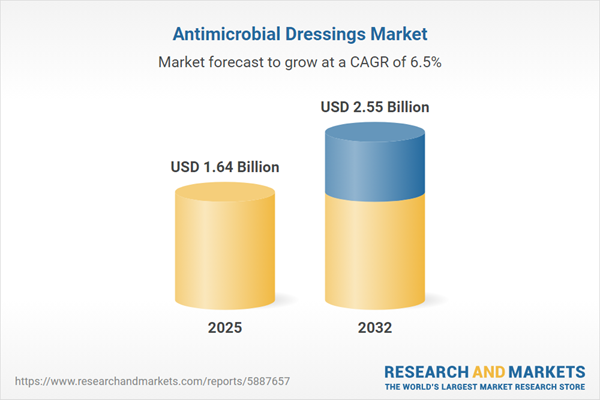Speak directly to the analyst to clarify any post sales queries you may have.
The antimicrobial dressings market is rapidly evolving as advanced infection control solutions become central to modern wound management strategies. With continual innovation and regulatory focus, industry leaders are capturing opportunities across clinical and remote care settings.
Market Snapshot: Growth and Strategic Perspective
The antimicrobial dressings market grew from USD 1.54 billion in 2024 to USD 1.64 billion in 2025 and is expected to sustain a CAGR of 6.49%, reaching USD 2.55 billion by 2032. This expansion is fueled by rising demand for infection prevention, the impact of chronic wound prevalence, and adoption of advanced wound care technologies across regions.
Scope & Segmentation: Mapping the Landscape
- Dressing Type: Alginate, Film, Sheet, Hydrocolloid Film, Transparent Film, Foam, Gel, Hydrogel (Amorphous and Sheet), Powder
- Agent Type: Honey, Iodine, Polyhexamethylene Biguanide (PHMB), Silver
- End User: Clinics, Home Healthcare, Hospitals (Private Hospitals, Public Hospitals)
- Wound Type: Acute Wounds, Burn Wounds, Chronic Wounds
- Regions Covered: Americas (North America: United States, Canada, Mexico; Latin America: Brazil, Argentina, Chile, Colombia, Peru), Europe, Middle East & Africa (Europe: United Kingdom, Germany, France, Russia, Italy, Spain, Netherlands, Sweden, Poland, Switzerland; Middle East: United Arab Emirates, Saudi Arabia, Qatar, Turkey, Israel; Africa: South Africa, Nigeria, Egypt, Kenya), Asia-Pacific (China, India, Japan, Australia, South Korea, Indonesia, Thailand, Malaysia, Singapore, Taiwan)
- Leading Companies: Smith & Nephew plc, 3M Company, Mölnlycke Health Care AB, ConvaTec Group plc, Coloplast A/S, B. Braun Melsungen AG, Paul Hartmann AG, Essity AB, Urgo Medical SA, Medline Industries, LP
Key Takeaways for Decision-Makers
- Novel antimicrobial dressing technologies harness nanotechnology, sustained-release agents, and bioengineered polymers, offering multifaceted benefits including infection control and wound healing acceleration.
- Integration of telehealth and digital monitoring is extending advanced wound care beyond hospitals, enabling real-time therapy adjustments and improved compliance.
- Regulatory reforms now prioritize demonstrated biocompatibility and efficacy, prompting manufacturers to invest in clinical validation and real-world evidence gathering.
- End-user preferences are shifting toward ease of use and versatility, especially in ambulatory and home settings, boosting demand for user-friendly formats like hydrogels and self-adherent sheets.
- Manufacturers are increasingly embedding sustainability by developing biodegradable materials and optimizing packaging, aligning with evolving healthcare environmental priorities.
Tariff Impact: Navigating Trade and Sourcing Complexities
Recent U.S. tariff adjustments on raw materials have led manufacturers to diversify sourcing and strengthen regional supply chains. Firms are forming new partnerships in Southeast Asia and Latin America, reshoring production facilities, and adopting lean manufacturing practices to manage pricing and mitigate risk. These actions are driving heightened scrutiny of product value among healthcare providers, emphasizing the importance of transparent cost-benefit communication and responsive supply chain strategies.
Methodology & Data Sources
This analysis integrates comprehensive secondary research from peer-reviewed literature, clinical and regulatory data, and government health statistics. Primary research engaged wound care clinicians, procurement directors, and supply chain managers. Triangulation and thematic analysis verified data integrity and illuminated emerging trends for actionable insight.
Why This Report Matters
- Enables strategic alignment with current clinical, regulatory, and technological trends in antimicrobial dressings.
- Supports informed investment and partnership decisions by providing a clear overview of product, regional, and end-user dynamics.
- Positions industry leaders to anticipate disruptive shifts, strengthen competitive advantage, and drive innovation in advanced wound care.
Conclusion
The antimicrobial dressings market is advancing through innovation, regulatory rigor, and global supply chain adaptation. Equipped with these insights, stakeholders are positioned to capture emerging opportunities, optimize strategies, and advance patient care standards.
Additional Product Information:
- Purchase of this report includes 1 year online access with quarterly updates.
- This report can be updated on request. Please contact our Customer Experience team using the Ask a Question widget on our website.
Table of Contents
3. Executive Summary
4. Market Overview
7. Cumulative Impact of Artificial Intelligence 2025
Companies Mentioned
The companies profiled in this Antimicrobial Dressings market report include:- Smith & Nephew plc
- 3M Company
- Mölnlycke Health Care AB
- ConvaTec Group plc
- Coloplast A/S
- B. Braun Melsungen AG
- Paul Hartmann AG
- Essity AB
- Urgo Medical SA
- Medline Industries, LP
Table Information
| Report Attribute | Details |
|---|---|
| No. of Pages | 180 |
| Published | October 2025 |
| Forecast Period | 2025 - 2032 |
| Estimated Market Value ( USD | $ 1.64 Billion |
| Forecasted Market Value ( USD | $ 2.55 Billion |
| Compound Annual Growth Rate | 6.4% |
| Regions Covered | Global |
| No. of Companies Mentioned | 11 |









